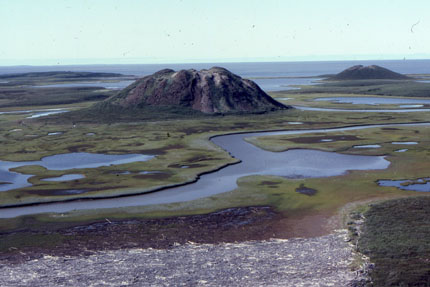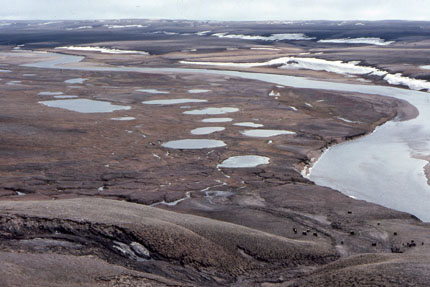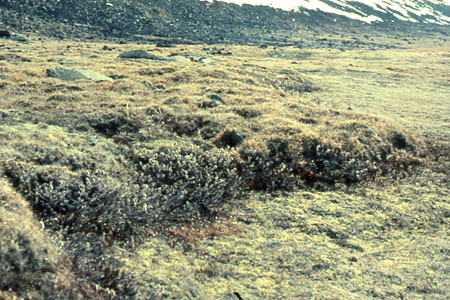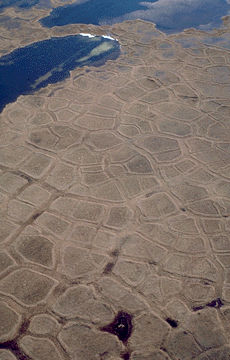The term "periglacial" was first proposed by Walery von Lozinski in 1909 to describe frost-weathering conditions in the Carpathian Mountains of central Europe. Subsequently, the concept of a "periglacial zone" developed that referred to the climatic and geomorphic conditions of areas peripheral to the Pleistocene ice sheets and glaciers. Theoretically, this was a tundra region extending as far south as the treeline. However, the modern definition encompasses a wide range of cold, nonglacial conditions, regardless of their proximity to glaciers, either in time or space. Periglacial environments exist not only in the high latitude and tundra regions of northern Canada (Yukon, Northwest Territories, Nunavut, Labrador), but also in areas south of treeline in the Northwest Territories, Yukon, and the northern parts of British Columbia, Alberta, and Saskatchewan, and in northern Manitoba, northern Ontario, northern Québec and western Newfoundland and Labrador. Periglacial conditions also occur in the high altitude (alpine) regions of both eastern and western Canada (eg, Monts Chic-Chocs of Québec; Western Cordillera of Alberta and British Columbia).
Approximately 50% of the land surface of Canada currently experiences either intense frost action or the presence of permafrost, or both. All gradations exist between environments in which frost-action processes dominate and where all or a major part of the landscape is the result of such processes, and those in which frost action processes are subservient to others. Complicating factors are the varying susceptibilities of different rock types to frost action and the fact that there is no perfect correlation between areas of intense frost action and areas underlain by permafrost. For example, large areas of northern Canada have only recently emerged from the late Wisconsinan glaciation, and periglacial processes currently serve merely to modify their glacial landforms. However, in those areas of Canada that have experienced longer histories of cold nonglacial conditions (eg, northern interior Yukon, northwestern Banks Island and certain other high-arctic islands), landscapes are more likely to be in equilibrium with current periglacial conditions.
Processes unique to periglacial environments include the formation of permafrost, the development of thermal-contraction cracks, the thawing of permafrost (the formation of thermokarst), the formation of wedge and injection ice, and certain mass movement processes that are enhanced by the presence of permafrost (eg, active-layer detachment failures). Other processes, not necessarily restricted to periglacial environments, are important because of their high magnitude or frequency in cold, nonglacial conditions. These include ice segregation, seasonal frost action, and various forms of instability and relatively rapid mass movement (eg, solifluction, the slow gravity-induced downslope movement of water-saturated debris). Nearly all frost-action processes operate in conjunction with the freezing of water.
The most distinctive periglacial landforms are those associated with permafrost. The most widespread are tundra polygons, which are formed by thermal-contraction cracking and divide the ground surface up into polygonal nets approximately 20-30 m in dimension. Water often penetrates the cracks to form ice wedges several metres deep and up to 1-2 m wide near the surface. In drier environments, mineral soil fills the cracks and sand wedges result. Ice-cored hills (pingos) are unique periglacial landforms but do not occur in all periglacial landscapes because they result from specific geomorphic and hydrologic conditions that severely limit their occurrence. Other aggradational permafrost landforms, such as palsas and peat plateaus, are associated with ice segregation. Ground-ice slumps, thaw lakes and irregular depressions (thermokarst) resulting from the thaw and erosion of ice-rich permafrost constitute other permafrost-related periglacial landforms.
Many periglacial phenomena result from frost wedging and the cryogenic weathering of exposed bedrock. Frost wedging is associated with the freezing and expansion of water penetrating joints and bedding planes. The details of cryogenic weathering are still poorly understood. Coarse, angular rock debris (blockfields, or felsenmeer), usually attributed to frost wedging or cryogenic weathering, occurs widely over large areas north of treeline and at high elevations in mountains. Frost-heaved bedrock blocks are common on the Precambrian Shield and extensive talus (scree) slopes are common in the mountains of both eastern Canada (Baffin and Ellesmere islands) and the northwestern Canadian Arctic (Western Cordillera of Yukon and Northwest Territories). In many areas, angular, frost-shattered rocky outcrops (tors) stand above the debris-covered surfaces, reflecting more resistant bedrock. These are common in sedimentary rocks, especially in the arctic islands (eg, Somerset Island); however, in the unglaciated uplands of interior Yukon, flat, erosional surfaces (cryoplanation terraces) and tors are developed upon old and resistant metamorphic bedrock terrain.
Agents of sediment transport and periglacial slope modification include 1) frost creep, the ratchetlike movement that occurs when soil, during a freeze-thaw cycle, expands normally to the surface and settles in a more nearly vertical direction, and 2) solifluction. Where solifluction occurs on or above frozen ground, it is termed gelifluction. Solifluction lobes, sheets and terraces are especially well developed above treeline and adjacent to sites of perennial snowbanks.
The small-scale relief of periglacial regions is characterized by various patterned ground phenomena. These are often related to cryoturbation, the lateral and vertical displacement of soil that accompanies seasonal or diurnal freezing and thawing. The most widespread are nonsorted circles or nets, typically 1-2 m in diameter and up to 0.5 m high. They occur widely in the Mackenzie Valley wherever fine-textured and poorly-drained sediments exist. In Keewatin, morphologically similar forms caused by density differences in saturated sediments are termed "mud boils." A wide range of nonsorted and sorted forms of patterned ground have been described from other parts of northern Canada, and no single explanation is applicable to all. Some are relict, as on the summits of the Monts Chic-Chocs, Québec, while others are currently active under present conditions.
See also Physiographic Regions.

 Share on Facebook
Share on Facebook Share on X
Share on X Share by Email
Share by Email Share on Google Classroom
Share on Google Classroom









